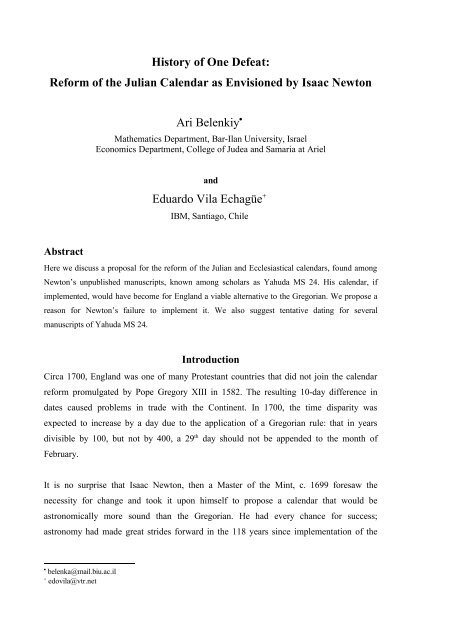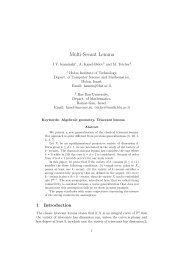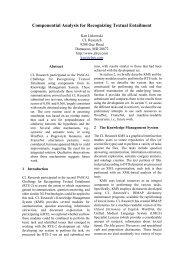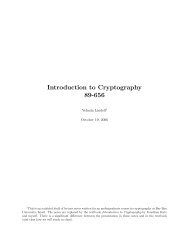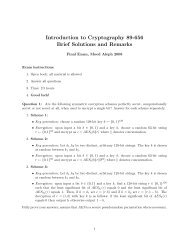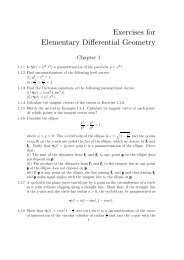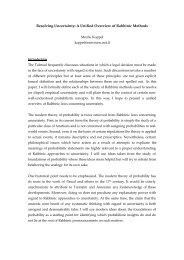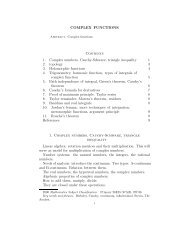Reform of the Julian Calendar as Envisioned by Isaac Newton
Reform of the Julian Calendar as Envisioned by Isaac Newton
Reform of the Julian Calendar as Envisioned by Isaac Newton
Create successful ePaper yourself
Turn your PDF publications into a flip-book with our unique Google optimized e-Paper software.
History <strong>of</strong> One Defeat:<br />
<strong>Reform</strong> <strong>of</strong> <strong>the</strong> <strong>Julian</strong> <strong>Calendar</strong> <strong>as</strong> <strong>Envisioned</strong> <strong>by</strong> <strong>Isaac</strong> <strong>Newton</strong><br />
Ari Belenkiy <br />
Ma<strong>the</strong>matics Department, Bar-Ilan University, Israel<br />
Economics Department, College <strong>of</strong> Judea and Samaria at Ariel<br />
and<br />
Eduardo Vila Echagüe <br />
IBM, Santiago, Chile<br />
Abstract<br />
Here we discuss a proposal for <strong>the</strong> reform <strong>of</strong> <strong>the</strong> <strong>Julian</strong> and Ecclesi<strong>as</strong>tical calendars, found among<br />
<strong>Newton</strong>’s unpublished manuscripts, known among scholars <strong>as</strong> Yahuda MS 24. His calendar, if<br />
implemented, would have become for England a viable alternative to <strong>the</strong> Gregorian. We propose a<br />
re<strong>as</strong>on for <strong>Newton</strong>’s failure to implement it. We also suggest tentative dating for several<br />
manuscripts <strong>of</strong> Yahuda MS 24.<br />
Introduction<br />
Circa 1700, England w<strong>as</strong> one <strong>of</strong> many Protestant countries that did not join <strong>the</strong> calendar<br />
reform promulgated <strong>by</strong> Pope Gregory XIII in 1582. The resulting 10-day difference in<br />
dates caused problems in trade with <strong>the</strong> Continent. In 1700, <strong>the</strong> time disparity w<strong>as</strong><br />
expected to incre<strong>as</strong>e <strong>by</strong> a day due to <strong>the</strong> application <strong>of</strong> a Gregorian rule: that in years<br />
divisible <strong>by</strong> 100, but not <strong>by</strong> 400, a 29 th day should not be appended to <strong>the</strong> month <strong>of</strong><br />
February.<br />
It is no surprise that <strong>Isaac</strong> <strong>Newton</strong>, <strong>the</strong>n a M<strong>as</strong>ter <strong>of</strong> <strong>the</strong> Mint, c. 1699 foresaw <strong>the</strong><br />
necessity for change and took it upon himself to propose a calendar that would be<br />
<strong>as</strong>tronomically more sound than <strong>the</strong> Gregorian. He had every chance for success;<br />
<strong>as</strong>tronomy had made great strides forward in <strong>the</strong> 118 years since implementation <strong>of</strong> <strong>the</strong><br />
<br />
belenka@mail.biu.ac.il<br />
edovila@vtr.net
2<br />
Gregorian reform in <strong>the</strong> Catholic countries. Besides, he w<strong>as</strong> <strong>Newton</strong>, after all. Not yet “Sir<br />
<strong>Isaac</strong>,” but <strong>Newton</strong>, <strong>the</strong> author <strong>of</strong> Principia Ma<strong>the</strong>matica Philosophie Naturalis.<br />
The manuscripts, known <strong>as</strong> Yahuda MS 24 after So<strong>the</strong><strong>by</strong>’s 1936 auction, were never<br />
published, though a draft <strong>of</strong> his letter to <strong>the</strong> Bishop <strong>of</strong> Worcester proves that <strong>Newton</strong> made<br />
an effort to convince <strong>the</strong> politically preeminent <strong>of</strong> <strong>the</strong> advantages <strong>of</strong> his calendar system.<br />
We first give a brief account <strong>of</strong> <strong>Newton</strong>’s system, subdivided into a historical and a purely<br />
calendrical part; <strong>the</strong> latter in turn is subdivided into <strong>the</strong> solar, se<strong>as</strong>onal, and lunar parts <strong>of</strong><br />
his system; and, finally, his proposed ecclesi<strong>as</strong>tical reform. We present some general<br />
discussion and pose some open questions. A transcript <strong>of</strong> <strong>Newton</strong>’s own manuscript is in<br />
<strong>the</strong> Appendix. The first brief description <strong>of</strong> <strong>the</strong> manuscripts w<strong>as</strong> made <strong>by</strong> David C<strong>as</strong>tilejo,<br />
a <strong>Newton</strong>ian scholar, at <strong>the</strong> request <strong>of</strong> <strong>the</strong> Hebrew University in Jerusalem, and we<br />
preserved his cataloguing numbers - A, B, C, D, E, F, G. - throughout <strong>the</strong> text, introducing<br />
additional pagination on <strong>the</strong> top <strong>of</strong> <strong>the</strong> letters.<br />
Historical Part<br />
In his letter to <strong>the</strong> Bishop <strong>of</strong> Worcester (draft F) <strong>Newton</strong> gives a brief sketch <strong>of</strong> historical<br />
calendars. The original calendar, handed down <strong>by</strong> <strong>the</strong> Biblical patriarch Noah, w<strong>as</strong><br />
lunisolar. Egyptians worked only with a 365-day solar year. Julius Caesar improved <strong>the</strong><br />
Egyptian calendar <strong>by</strong> taking into account <strong>the</strong> remaining quarter <strong>of</strong> a day. Chaldeans used a<br />
lunisolar calendar and Jews obtained it from <strong>the</strong>m while exiled in Ba<strong>by</strong>lonia, <strong>as</strong> proved <strong>by</strong><br />
<strong>the</strong>ir identical names for <strong>the</strong> lunar months. In <strong>the</strong> desert, Moses could not observe new and<br />
full moons and appointed <strong>the</strong> first days <strong>of</strong> <strong>the</strong> months arbitrarily; but King David appointed<br />
12 guards over Eretz Israel from <strong>the</strong> 12 tribes, according to <strong>the</strong> celestial 12-month division.<br />
Solar Part<br />
In three consecutive drafts A1-A3 <strong>of</strong> <strong>the</strong> proposed reform, <strong>Newton</strong> quotes three different<br />
values for <strong>the</strong> solar year, <strong>as</strong>suming that it is shorter than <strong>the</strong> <strong>Julian</strong> year (<strong>of</strong> 365d 6h) <strong>by</strong> ‘11<br />
1/4 m’ (A1 [p. 1]); ‘11 1/5 m’ (A2 [p. 5]); first ‘11 1/15 m’ and, finally, ‘11m and 3 or 4s’<br />
(A3 [p. 8]). The first two values better fit <strong>the</strong> proposed <strong>Newton</strong>ian reform:<br />
(1) to drop February 29 in years divisible <strong>by</strong> 100 but not in those divisible <strong>by</strong> 500;<br />
(2) to add February 30 in years divisible <strong>by</strong> 5,000.<br />
2
3<br />
The first rule makes <strong>Newton</strong>’s calendar year shorter than <strong>the</strong> <strong>Julian</strong> <strong>by</strong> only 11m 31s; <strong>the</strong><br />
second adds back about 17s. The final value is about 365d 5h 48m 46s, just in between <strong>the</strong><br />
first two values (with 45s and 48s respectively).<br />
Fortuitously, <strong>the</strong> final value (365d 5h 48m 46s) almost precisely matches <strong>the</strong> modern value<br />
<strong>of</strong> <strong>the</strong> tropical year, 365.2422d. Such a calendar would l<strong>as</strong>t in historical time faultlessly. 1<br />
However, in A3, <strong>Newton</strong> crosses out <strong>the</strong> second value and puts <strong>the</strong> value 365d 5h 48m 56s<br />
in one place and 365d 5h 48m 56/7s in ano<strong>the</strong>r. In D1 [p.21], discussing <strong>the</strong> advantages <strong>of</strong><br />
his calendar, however, he claims that his calendar would err only a day in 10,000 years,<br />
while <strong>the</strong> Gregorian would err a day in 5,000 years. Since <strong>the</strong> Gregorian year is equal to<br />
365d 5h 49m 12s, <strong>Newton</strong> made comparison <strong>of</strong> errors for <strong>the</strong> year <strong>of</strong> 365d 5h 48m 55s.<br />
<strong>Newton</strong> saw also ano<strong>the</strong>r advantage, beyond precision, in <strong>the</strong> arrangement <strong>of</strong> <strong>the</strong> solar part<br />
<strong>of</strong> his system. His calendar year (46s) is shorter than <strong>the</strong> true year (55s) and <strong>the</strong>refore its<br />
state gradually “approaches <strong>the</strong> state it had in <strong>the</strong> age <strong>of</strong> Christ” so that in 30,000 years, <strong>the</strong><br />
vernal equinox would fall on March 24, and in 110,000 years, on April 1.<br />
Lunar Part<br />
<strong>Newton</strong> suggested creating a Great Lunar Cycle <strong>of</strong> 49 months, subdivided into three<br />
smaller cycles <strong>of</strong> 17, 15, and 17 months respectively. In each <strong>of</strong> <strong>the</strong> three cycles, <strong>the</strong> odd<br />
months would have 30 days and <strong>the</strong> even, 29 days. Then 49 months would consist <strong>of</strong> 1447<br />
days, and thus <strong>Newton</strong>’s mean month would be equal to 29d 12h 44m 4.9s.<br />
The synodic month, <strong>Newton</strong> believed to be true, can be found from his computations in C2<br />
[p. 18], intended to find <strong>the</strong> time <strong>of</strong> mean Full Moons for many years into <strong>the</strong> future. There<br />
<strong>Newton</strong> used <strong>the</strong> following parameters:<br />
Epoch: 1701.0 <strong>Julian</strong> <strong>Calendar</strong> = Dec 31, noon, 1700 <strong>Julian</strong> <strong>Calendar</strong> (Jan<br />
11, noon, 1701 Gregorian <strong>Calendar</strong>).<br />
At Epoch [Moon Sun] difference in longitude: 24° 33' 57".<br />
The increment (modulo full circles) for 60 years: 1s 10° 14' 12".<br />
1<br />
The error will be less than 1 day in 100,000 years <strong>as</strong>suming that <strong>the</strong> Earth stops slowing down.<br />
3
4<br />
From <strong>the</strong> l<strong>as</strong>t parameter we calculated that <strong>Newton</strong> <strong>as</strong>sumed a daily incre<strong>as</strong>e in elongation<br />
to be 12° 11' 26.7" and <strong>the</strong>refore his synodic month w<strong>as</strong> 29d 12h 44m 3.16s. 2 This is 1.74s<br />
smaller than <strong>the</strong> value coming from his calendar. The 1.74s accumulate to 3 hours in 500<br />
years, in complete agreement with his memorandum on <strong>the</strong> advantages <strong>of</strong> his calendar<br />
(drafts D1 [p. 22]) and D2 [p. 24]).<br />
To organize <strong>the</strong> lunar calendar in a comparatively short, 4,000-year cycle, <strong>Newton</strong><br />
proposed two different methods. The “deductive” would drop four months in those Great<br />
Cycles that embrace <strong>the</strong> end <strong>of</strong> 500, 1000, 1500, etc., years. 3 The goal <strong>of</strong> this procedure is<br />
not clear and will be discussed fur<strong>the</strong>r in <strong>the</strong> Discussion section. The o<strong>the</strong>r, an “additive”<br />
device, w<strong>as</strong> suggested in A2 [p. 7]: add two months every 250 years, which is <strong>the</strong> same <strong>as</strong><br />
adding 32 months every 4,000 years. In A3 [p.10], <strong>Newton</strong> suggested adding one more day<br />
(to <strong>the</strong> l<strong>as</strong>t month <strong>of</strong> 29 days) in 4,000 years. To clarify his intentions, let us make several<br />
computations. In every 500 calendar years <strong>the</strong>re are<br />
325.25 * 500 - 4 = 182,621 d.<br />
Divided <strong>by</strong> 1447, <strong>the</strong> l<strong>as</strong>t number gives 126 (Great Cycles) and remainder 299 (days). In<br />
<strong>the</strong> 4 months that have to be added every 500 years, <strong>the</strong>re are 118 days. Subtracting 118<br />
from 299 we get 181 days. To find <strong>the</strong> total remainder for <strong>the</strong> 4,000-year period, we should<br />
multiply it <strong>by</strong> 8:<br />
181 d * 8 = 1448 d = 1447 d +1 d,<br />
or a Great Cycle and a day. Overall, <strong>the</strong>re are<br />
126 * 8 +1 = 1,009 Great Cycles<br />
while 8*4 =32 months remain outside. Therefore <strong>Newton</strong>’s “m<strong>as</strong>ter equation” is<br />
1,460,968d = 4,000y = 1,009 Great cycles + 32 months +1 d = 49,473 months + 1d. (1)<br />
2<br />
In Principia, <strong>Newton</strong> <strong>as</strong>sumed a slightly greater value (though he never quotes <strong>the</strong> value<br />
<strong>of</strong> <strong>the</strong> synodic month explicitly, it can be recomputed from <strong>the</strong> value <strong>of</strong> <strong>the</strong> sidereal year<br />
and sidereal month). The 1713 Edition, Book 3, Proposition 37, Problem 18, Corollary 7<br />
gives 27d 7h 43 1/5m for a sidereal month. The value <strong>of</strong> a sidereal year (365.2565d) w<strong>as</strong><br />
cited in <strong>the</strong> 1726 edition <strong>of</strong> Principia, Book 3, Phenomenon 4. This brings <strong>the</strong> synodic<br />
month to <strong>the</strong> Ptolemaic value <strong>of</strong> 29d 12h 44m 3.3s. It is interesting that <strong>the</strong> 1687 edition<br />
gives only <strong>the</strong> approximate value, 27d 7h 43m, for a sidereal month, while <strong>the</strong> 1726 edition<br />
gives 43 4/9m, where - N.B.! - <strong>the</strong> l<strong>as</strong>t fraction is an obvious typo. Henry Pemberton w<strong>as</strong><br />
no match to Roger Cotes!<br />
3<br />
Ei<strong>the</strong>r 8 months out <strong>of</strong> a 15-month small cycle every 1,000 years (in <strong>the</strong> draft A1), or <strong>the</strong><br />
two l<strong>as</strong>t months in both 17-month small cycles every 500 years (in D1).<br />
4
5<br />
According to A3, <strong>the</strong> lone ‘1 day’ had to be absorbed into <strong>the</strong> l<strong>as</strong>t month <strong>of</strong> 29 days. This<br />
makes <strong>the</strong> value <strong>of</strong> mean month equal to<br />
m_month = 1,460,968d / 49,473 months = 29.53061266 d = 29d 12h 44m 6.33s, (*)<br />
which is 3.5 seconds greater than <strong>the</strong> modern value <strong>of</strong> <strong>the</strong> mean month. This means that<br />
<strong>the</strong> price for having a comparatively short, 4,000-year cycle, will be a two-day delay <strong>of</strong> <strong>the</strong><br />
calendar moon against its true position.<br />
In A1-A3, <strong>Newton</strong> left two blank spaces, intended to fix January 1, 1701, inside <strong>the</strong> Great<br />
Cycle. In C2 [p. 18] he considered inter alia two possibilities:<br />
ei<strong>the</strong>r January 1, 1701, becomes <strong>the</strong> 2nd day <strong>of</strong> <strong>the</strong> 1st month <strong>of</strong> <strong>the</strong> 2nd Great Cycle,<br />
or January 1, 1701, becomes <strong>the</strong> 2nd day <strong>of</strong> <strong>the</strong> 8th month <strong>of</strong> <strong>the</strong> 3rd Great Cycle.<br />
Division <strong>of</strong> <strong>the</strong> Year and <strong>the</strong> Ecclesi<strong>as</strong>tical <strong>Calendar</strong><br />
In drafts A1 and A2, <strong>Newton</strong> complains that <strong>the</strong> <strong>Julian</strong> calendar w<strong>as</strong> maimed <strong>by</strong> <strong>the</strong><br />
Roman Senate reform, made in 8 BC to honor Augustus <strong>by</strong> adding a 31st day to <strong>the</strong> month<br />
named after him and depriving February <strong>of</strong> a day. He believed that Pope Gregory could<br />
score a great accomplishment if he were to reverse that transfer and rearrange <strong>the</strong> months.<br />
However, in draft C1 [p. 13], <strong>Newton</strong> put forward quite a different idea - that <strong>of</strong> close<br />
imitation <strong>of</strong> <strong>the</strong> contemporary se<strong>as</strong>onal divisions <strong>of</strong> <strong>the</strong> year - a temptation that later w<strong>as</strong><br />
tried repeatedly <strong>by</strong> revolutionary nations. <strong>Newton</strong> suggested <strong>as</strong>signing 30 days to all winter<br />
months and 31 days to all summer months save <strong>the</strong> l<strong>as</strong>t one in <strong>the</strong> non-leap years. 4<br />
<strong>Newton</strong>’s o<strong>the</strong>r proposed amendments are:<br />
1) From <strong>the</strong> year 1701 on, <strong>the</strong> year should begin on January 1 and not on March 25.<br />
2) E<strong>as</strong>ter will be kept on <strong>the</strong> next Sunday after <strong>the</strong> 14th <strong>of</strong> <strong>the</strong> lunar month, which shall<br />
begin after March 7.<br />
3) All <strong>the</strong> moveable fe<strong>as</strong>ts (Pentecost, etc.) that are dependent on E<strong>as</strong>ter have to be set<br />
after <strong>the</strong> date <strong>of</strong> E<strong>as</strong>ter is calculated.<br />
4<br />
This arrangement had to correspond to <strong>the</strong> fact that in his time spring+summer+<br />
fall+winter = 93d+ 93.5d+ 89.6d+ 89.1d. The solar apogee c. 1700 w<strong>as</strong> at ca. 97°, roughly<br />
dividing summer-spring and fall-winter semicircles in half.<br />
5
6<br />
According to A1-A3, all <strong>the</strong> fixed fe<strong>as</strong>ts had to stay in place after <strong>the</strong> first 11 days <strong>of</strong><br />
December 1700 were omitted. However, in <strong>the</strong> tables <strong>of</strong> C2 [pp. 15,16], <strong>Newton</strong> suggested<br />
two quite different ways to deal with <strong>the</strong> fixed fe<strong>as</strong>ts (Christm<strong>as</strong>, Lady Day, etc.). He<br />
arranged <strong>the</strong> year in two parallel columns, shifted <strong>by</strong> some 22-23 days against one ano<strong>the</strong>r,<br />
marking along <strong>the</strong> way all <strong>the</strong> fixed fe<strong>as</strong>ts. The goal w<strong>as</strong> to return all <strong>the</strong> fe<strong>as</strong>ts to <strong>the</strong>ir<br />
original positions, <strong>as</strong> set in <strong>the</strong> 1st century (though from a brief historical discourse on <strong>the</strong><br />
introduction <strong>of</strong> <strong>the</strong> fe<strong>as</strong>ts from Emperor Trajan’s tenure on, it is clear that only three major<br />
fe<strong>as</strong>ts were established in <strong>the</strong> 1st century).<br />
The right column (in c<strong>as</strong>e <strong>the</strong> arrangement <strong>of</strong> length <strong>of</strong> <strong>the</strong> months remains unchangeable<br />
and none <strong>of</strong> <strong>the</strong> days were omitted) suggested moving <strong>the</strong> fixed fe<strong>as</strong>ts to <strong>the</strong> contemporary<br />
cardinal points: Christm<strong>as</strong> would be moved to <strong>the</strong> winter solstice (December 11), Lady<br />
Day to <strong>the</strong> vernal equinox (March 11), etc. 5 In September thirteen days are missing - from<br />
<strong>the</strong> 16th to <strong>the</strong> 28th.<br />
The left column w<strong>as</strong> arranged according to <strong>the</strong> new division <strong>of</strong> <strong>the</strong> year. September 31 had<br />
to be an intercalary day. Christm<strong>as</strong> w<strong>as</strong> set on January 3, Lady Day on April 3. For that, he<br />
w<strong>as</strong> ready to omit 22-23 days from <strong>the</strong> calendar, which would move all <strong>the</strong> fe<strong>as</strong>ts 8-9 days<br />
earlier, <strong>as</strong> he promised in draft C1 [p. 13].<br />
Discussion and Open Questions<br />
1. Solar Part<br />
In <strong>the</strong> two drafts A, he described <strong>the</strong> value <strong>of</strong> <strong>the</strong> year <strong>as</strong> ‘<strong>Julian</strong> without c. 11 1/4 minutes’<br />
(in A1) and ‘<strong>Julian</strong> without c. 11 1/5 minutes’ (in A2). However, in <strong>the</strong> fair copy A3,<br />
<strong>Newton</strong> replaced <strong>the</strong> l<strong>as</strong>t fraction with ‘11 1/15m’ and later even with ‘11 1/20 m’. The<br />
l<strong>as</strong>t value, equal ‘365d 5h 48m 57s’ also appeared on <strong>the</strong> margin <strong>of</strong> D1 [p. 23], and a<br />
practically identical value w<strong>as</strong> used in <strong>Newton</strong>’s Theory <strong>of</strong> Moon’s Motion [2], published<br />
<strong>by</strong> David Gregory in 1702.<br />
Though <strong>the</strong> explicit “118 years since Gregorian reform” in all three drafts A suggests only<br />
one possible dating - year 1699-1700 - it is difficult to believe that during one year <strong>Newton</strong><br />
three times changed his opinion on <strong>the</strong> length <strong>of</strong> a solar year, <strong>the</strong> most important parameter<br />
5<br />
The rest were treated accordingly: St. Mat<strong>the</strong>w to Feb 10, St. Mark to Apr 11, Sts. Philip<br />
and James to Apr 17.<br />
6
7<br />
<strong>of</strong> lunisolar <strong>the</strong>ory. We hypo<strong>the</strong>size that first two drafts A1 and A2 were composed much<br />
earlier and only waited for <strong>the</strong> proper time to be published.<br />
The value <strong>Newton</strong> stayed with in writing drafts D1 and D2 w<strong>as</strong> ‘365d 5h 48m 55s.’ Only<br />
this value satisfactorily explains why he believed that <strong>the</strong> Gregorian calendar errs a day in<br />
10,000 years, while his own errs a day in 5,000 years. However, that value leads to <strong>the</strong><br />
continued fraction<br />
365.25 - 365.2423 = 0.0077 = [0,1,3,2,1,7]/100<br />
where <strong>the</strong> l<strong>as</strong>t approximant, 77/10,000, points to <strong>the</strong> cycle <strong>of</strong> 10,000 years, twice <strong>the</strong><br />
greater cycle than finally chosen <strong>by</strong> <strong>Newton</strong>. This means that in <strong>the</strong> actual calendar,<br />
<strong>Newton</strong> did not use this value. A question arises <strong>of</strong> how <strong>Newton</strong> actually obtained <strong>the</strong><br />
values finishing with 55s and 57s.<br />
A table, Annales de L’Observatoire de Bruxelles, taken from <strong>the</strong> NASA Astrophysics Data<br />
System 6 provides <strong>the</strong> following data:<br />
48m 45.5s for 1602 Tycho Brahe (Astron. Instaur progym),<br />
48m 57.6s for 1627 Johannes Kepler (Tabulae Rudolphine),<br />
49m 4.5s for 1645 Boulliaud (Astronomia philolaica),<br />
48m 40s for 1651 Riccioli (Alm. Nov.),<br />
48m 8s for 1665 Street (Carolician tables),<br />
48m 57.5s for 1687 Flamsteed (<strong>Newton</strong>, Principia) 7 , and<br />
48m 34.5s for 1719 Edmond Halley (Tabulae Astronom).<br />
The most remarkable feature <strong>of</strong> this table is that Flamsteed adopted a value almost<br />
identical to that <strong>of</strong> Kepler while disregarding what w<strong>as</strong> found later <strong>by</strong> his close<br />
contemporaries. The bridge between <strong>the</strong> two <strong>as</strong>tronomers w<strong>as</strong> Jeremiah Horrox. Though it<br />
is an open question why <strong>Newton</strong> stayed for a while with Tycho’s value, we can tell why he<br />
later switched to Kepler’s. An immediate answer is that Flamsteed picked up <strong>the</strong><br />
Horroxian lunar <strong>the</strong>ory toge<strong>the</strong>r with its major parameters, like mean solar and lunar<br />
motions, while Horrox largely adopted Kepler’s values. Collaborating in <strong>the</strong> late 1690s<br />
6<br />
Web site at .<br />
7<br />
We did not find in Principia any support for <strong>the</strong> value <strong>as</strong>cribed to Flamsteed. However<br />
this is exactly <strong>the</strong> value we deduced from <strong>Newton</strong>’s 1702 Theory <strong>of</strong> <strong>the</strong> Moon’s Motion<br />
[2]. The value we deduced from Horroxian tables [1] is 365d 5h 48m 59.5s.<br />
7
8<br />
with John Flamsteed, Astronomer Royal, in constructing a new Theory <strong>of</strong> <strong>the</strong> Moon,<br />
<strong>Newton</strong> picked up Flamsteed’s parameters for mean solar and lunar motions. 8<br />
Actually, <strong>the</strong>re is little factual evidence <strong>of</strong> Tycho’s influence on <strong>Newton</strong>’s views about <strong>the</strong><br />
Sun. 9 More likely, he used <strong>the</strong> equinoctial observations <strong>by</strong> Hipparchus, made about 1850<br />
years before <strong>Newton</strong>’s time. The 15-second discrepancy in <strong>the</strong> value <strong>of</strong> a year would<br />
accumulate, counting backward to <strong>the</strong> mid-2nd century BC, to <strong>the</strong> full 8-hour difference.<br />
Extensive computations in D1 [p. 21] show that <strong>Newton</strong> computed backward some <strong>of</strong> <strong>the</strong><br />
162-128 BC equinoxes, trying to find <strong>the</strong> best correlation with Hipparchus’ recorded<br />
observations in <strong>the</strong> same years. 10 There is no sign that he arrived at a definite conclusion.<br />
The question remains <strong>of</strong> how <strong>Newton</strong> decided on <strong>the</strong> length <strong>of</strong> <strong>the</strong> cycle, 5,000 years. The<br />
same page C2 [p.18] shows that <strong>Newton</strong> first had chosen 5,000 <strong>as</strong> his solar cycle and<br />
looked only for <strong>the</strong> number <strong>of</strong> days that had to be deleted from it. The procedure can be<br />
described <strong>as</strong> follows. The difference between <strong>the</strong> <strong>Julian</strong> year and <strong>the</strong> modern value for a<br />
tropical year, 365.2422 (365d 5h 48m 46s), converted into a continued fraction via<br />
365.25 - 365.2422 = 0.0078 = [0,1,3,1,1,5]/100<br />
yields <strong>the</strong> l<strong>as</strong>t rational approximant 39/5,000, indicating that in 5,000 years, precisely 39<br />
days have to be omitted.<br />
<strong>Newton</strong> found this number for <strong>the</strong> Gregorian year to be 37.5d, while for his b<strong>as</strong>ic<br />
procedure <strong>of</strong> omitting 4 days out <strong>of</strong> 500 - 40d. Two intermediate numbers 38d and 39d –<br />
led to years <strong>of</strong> 365d 5h 49m 4s and 365d 5h 48m 46s, respectively. It seems that <strong>Newton</strong><br />
chose <strong>the</strong> latter version <strong>by</strong> some external (<strong>the</strong>ological), ra<strong>the</strong>r than <strong>as</strong>tronomical<br />
considerations: <strong>the</strong> value he believed to be <strong>the</strong> true year (with 55s) lies exactly in between.<br />
The major consideration here w<strong>as</strong> his wish that <strong>the</strong> calendar year be shorter than <strong>the</strong> true<br />
one. In that c<strong>as</strong>e, <strong>the</strong> equinoxes would drift in <strong>the</strong> calendar to <strong>the</strong> positions <strong>the</strong>y occupied<br />
in <strong>the</strong> time <strong>of</strong> Jesus.<br />
8<br />
We venture to hypo<strong>the</strong>size that <strong>the</strong> Horroxian tables, published <strong>by</strong> Flamsteed in 1681,<br />
mark <strong>the</strong> inception <strong>of</strong> <strong>Newton</strong>’s interest in Keplerian planetary <strong>the</strong>ory, which soon would<br />
play a prominent role in Principia.<br />
9<br />
Westfall [8, p. 830] brings to light only one instance when Tycho’s manuscript (on<br />
comets) received <strong>Newton</strong>’s attention. <strong>Newton</strong> presented Tycho’s manuscript to <strong>the</strong> Royal<br />
Society, and <strong>as</strong> president, ordered it printed. It is unclear whe<strong>the</strong>r it w<strong>as</strong> his own<br />
manuscript, and if so, when he acquired it.<br />
10<br />
A kind <strong>of</strong> a precursor <strong>of</strong> <strong>the</strong> future “le<strong>as</strong>t squares method.”<br />
8
9<br />
2. Lunar part<br />
In a series <strong>of</strong> papers (see [3]), Heiner Lichtenberg clarified several important issues related<br />
to <strong>the</strong> Gregorian reform proper that are contained in <strong>the</strong> Explicatio written c. 1605 <strong>by</strong><br />
Clavius. The fa<strong>the</strong>r <strong>of</strong> <strong>the</strong> reform seemed to be fully aware <strong>of</strong> <strong>the</strong> possibility <strong>of</strong> future<br />
changes, but insisted on a so-called ‘Secular Principle’ that allows fur<strong>the</strong>r adjustments<br />
only in years divisible <strong>by</strong> 100. Though it is unclear whe<strong>the</strong>r <strong>Newton</strong> carefully read<br />
Clavius’ work, we see that he did respect this principle. 11<br />
Fur<strong>the</strong>r, <strong>Newton</strong> remarked that <strong>the</strong> lunar part <strong>of</strong> <strong>the</strong> Gregorian calendar designed for <strong>the</strong><br />
determination <strong>of</strong> E<strong>as</strong>ter is too hard to implement because it rests on 3 or 4 tables. It is true<br />
that changes in <strong>the</strong> Golden Numbers and Epacts at <strong>the</strong> centennial boundaries do not have<br />
clear rules in <strong>the</strong> Gregorian calendar. It is known, however [3,7], that <strong>the</strong> Gregorian<br />
calendar precipitates more than 43 changes in Epact during <strong>the</strong> next 100 centuries.<br />
Moreover, Heiner Lichtenberg [3] claimed to have discovered a fundamental equation<br />
governing <strong>the</strong> Gregorian calendar:<br />
5,700,000 y = 70, 499, 183 months = 2, 081, 882, 250 d<br />
Because <strong>the</strong> number <strong>of</strong> days is divisible <strong>by</strong> 7, this equation also represents <strong>the</strong> Grand Cycle<br />
<strong>of</strong> <strong>the</strong> Gregorian calendar.<br />
<strong>Newton</strong> did not leave us his Grand Cycle; however, it can be computed e<strong>as</strong>ily. If <strong>the</strong> lone<br />
‘1 day’ in equation (*) is not incorporated into one <strong>of</strong> <strong>the</strong> 29-day months, but is kept<br />
separate, <strong>the</strong>n after 30 cycles it would grow to 1 month. Noticing that 120,000 years call<br />
for 24 additional days (February 30), we come to <strong>the</strong> equation<br />
120,000 y = 1,484,191 months = 43,829,064 d. ($)<br />
This improves <strong>the</strong> value <strong>of</strong> <strong>the</strong> mean month back to<br />
m_month = 43,829,064 d / 1,484,191 months = 29.53060893 d = 29d 12h 44m 4.9s.<br />
11<br />
It is interesting that <strong>the</strong> 20th century witnessed several proposals to amend <strong>the</strong> Gregorian<br />
calendar that were greatly inferior to <strong>Newton</strong>’s - see a short review in [3].<br />
9
10<br />
Because <strong>the</strong> number <strong>of</strong> days in ($) is not divisible <strong>by</strong> 7, <strong>the</strong> <strong>Newton</strong>ian Grand Cycle is<br />
840,000 years. This cycle, however, is purely imaginary. The introduction <strong>of</strong> an extra<br />
month w<strong>as</strong> never approved <strong>by</strong> <strong>Newton</strong>. 12 The more subtle “deductive” device could be<br />
designed to absorb 1 extra day “naturally,” inside a simple algorithm. How it w<strong>as</strong> done is<br />
still an open question.<br />
In all three drafts A, <strong>the</strong> two blank spaces reserved for <strong>the</strong> beginning <strong>of</strong> <strong>the</strong> Great lunar<br />
cycle remained empty. Two dates appear in C2 [p. 18], which is filled with extensive<br />
computations, within <strong>the</strong> lunisolar parameters described above, in <strong>Newton</strong>’s Lunar Theory.<br />
The source for <strong>the</strong>se parameters appears to be Flamsteed’s 1681 Horroxian Lunar Theory.<br />
Computations, we made using a computer program [1], show only a 3 arc-seconds<br />
difference with <strong>the</strong> Horroxian daily elongation and lead to a synodic month identical with<br />
Horroxian synodic month <strong>of</strong> 29d 12 44m 3.16s. 13<br />
On <strong>the</strong> o<strong>the</strong>r hand, <strong>the</strong> parameters in C2 [p. 18] are nei<strong>the</strong>r consistent with <strong>Newton</strong>'s 1702<br />
Theory <strong>of</strong> <strong>the</strong> Moon’s Motion [2] nor with <strong>the</strong> mean positions <strong>of</strong> <strong>the</strong> Sun and Moon quoted<br />
in <strong>the</strong> 1713 and 1726 editions <strong>of</strong> <strong>the</strong> Principia, Book 3, Proposition XXXV. They differ<br />
from both <strong>by</strong> more than 2 arc-minutes. It is an accepted fact that <strong>Newton</strong> began work on<br />
his own lunar <strong>the</strong>ory in 1694-5. 14 The implication is that <strong>the</strong> computations in C2 [p. 18]<br />
should be dated sometime between 1681 and 1694.<br />
The two dates written in C2 [p. 18] suggest even more precise dating. Naming January 1,<br />
1701 <strong>as</strong> <strong>the</strong> 2nd day <strong>of</strong> <strong>the</strong> 1st month <strong>of</strong> <strong>the</strong> 2nd Great Cycle points to an epoch <strong>of</strong> January<br />
14, 1697, while naming January 1, 1701, <strong>as</strong> <strong>the</strong> 2nd day <strong>of</strong> <strong>the</strong> 8th month <strong>of</strong> <strong>the</strong> 3rd Great<br />
Cycle points to <strong>the</strong> epoch <strong>of</strong> June 1, 1692. As we know, <strong>the</strong> latter date (1692-3) is a time<br />
when <strong>Newton</strong> w<strong>as</strong> actively involved in a <strong>the</strong>ological exchange with John Locke and also<br />
w<strong>as</strong> afflicted with a mysterious ‘illness.’ 15 The draft C3 on ancient chronology could<br />
belong to this period, <strong>as</strong> well.<br />
12<br />
Though in <strong>the</strong> end <strong>of</strong> draft C1 [p. 14] he allowed ecclesi<strong>as</strong>tical authorities to intervene to<br />
correct Dominical letters.<br />
13<br />
The value we found in <strong>the</strong> Rudolphine Tables is almost identical: 29d 12h 44m 3.18s.<br />
14<br />
See Westfall, [8, pp. 540-48].<br />
15<br />
See Ibid [8, pp. 530-40].<br />
10
11<br />
Accordingly, December 31, 1700, w<strong>as</strong> simply a convenient choice to start a lunar cycle.<br />
Except for being near January 1, it implicitly swallows, <strong>as</strong> can be seen from <strong>the</strong> “m<strong>as</strong>ter<br />
equation” (1) above, one day remaining from <strong>the</strong> complete number <strong>of</strong> months. Because <strong>the</strong><br />
true elongation at noon w<strong>as</strong> more than 25°, it w<strong>as</strong> e<strong>as</strong>y to prove that <strong>the</strong> moon could be<br />
seen on that night at any location on Earth. To show that it could not be seen a night earlier<br />
(with true elongation at noon c. 15°) w<strong>as</strong> a tricky problem, dependent on <strong>the</strong> particular<br />
lunar visibility <strong>the</strong>ory; this will be reserved for ano<strong>the</strong>r paper. 16<br />
Epilogue<br />
The final question to be addressed is why <strong>Newton</strong> failed to publish his calendar. The<br />
standard answer is that he could have been afraid <strong>of</strong> public controversy. Still, he made sure<br />
that his highly controversial Chronology <strong>of</strong> Ancient Kingdoms Amended would be<br />
published after his death, and it w<strong>as</strong> (in 1728), while his calendar w<strong>as</strong> buried in a pile <strong>of</strong><br />
various o<strong>the</strong>r historical drafts.<br />
One answer is that in <strong>Newton</strong>’s eyes, his calendar - its major solar part - w<strong>as</strong> imperfect. As<br />
we saw, in every consecutive draft, <strong>Newton</strong> incre<strong>as</strong>ed his estimate for <strong>the</strong> true solar year<br />
from an initial 365d 5h 48m 45s to a final 365d 5h 48m 57s. Remarkably, in <strong>the</strong><br />
Chronology [6, p. 81], he incre<strong>as</strong>ed this value fur<strong>the</strong>r, rounding it up to 365d 5h 49m. 17<br />
With that, <strong>the</strong> Gregorian year w<strong>as</strong> only 12s greater than <strong>the</strong> “true” one, while <strong>the</strong><br />
<strong>Newton</strong>ian w<strong>as</strong> already c. 14s shorter.<br />
To conclude: drafts A1-A2-A3 were likely written in 1699, though <strong>the</strong> lengths <strong>of</strong> <strong>the</strong> solar<br />
year adopted in A1 and A2 are puzzling. Drafts C2-C3 and D1-D2 could be composed<br />
earlier, in 1692-3, after <strong>Newton</strong>’s acquaintance with <strong>the</strong> Horroxian lunar <strong>the</strong>ory and before<br />
his own work on <strong>the</strong> lunar <strong>the</strong>ory. Draft F w<strong>as</strong> composed after 1705 because <strong>the</strong> title “Sir”<br />
preceded <strong>Newton</strong>’s name. Ei<strong>the</strong>r <strong>the</strong> imperfection <strong>of</strong> his lunar system or his growing<br />
16<br />
In draft E, discussed in a subsequent paper, <strong>Newton</strong> grossly relied on <strong>the</strong> lunar visibility<br />
<strong>the</strong>ory described <strong>by</strong> Maimonides. The large sou<strong>the</strong>rn latitude <strong>of</strong> <strong>the</strong> moon (ca. 4°) can be a<br />
re<strong>as</strong>on for declaring non-visibility. See details in Neugebauer [4].<br />
17<br />
This value, even greater <strong>by</strong> 3s, can be computed from <strong>the</strong> speed <strong>of</strong> <strong>the</strong> equinoxes (50”<br />
per year = 0.0141d) found in all three editions <strong>of</strong> Principia, and <strong>the</strong> value <strong>of</strong> a sidereal year<br />
(365.2565d), in <strong>the</strong> 3rd edition <strong>of</strong> <strong>the</strong> Principia, Book 3, Phenomenon 4. The fact that <strong>the</strong><br />
value <strong>of</strong> a sidereal year w<strong>as</strong> given with 1/10,000d precision allows for <strong>the</strong> value 365d 5h<br />
49m.<br />
11
12<br />
disappointment with <strong>the</strong> solar part caused <strong>Newton</strong> to abandon his grand project. We are<br />
unaware whe<strong>the</strong>r <strong>the</strong> letter intended for <strong>the</strong> Bishop <strong>of</strong> Worcester w<strong>as</strong> ever sent to him,<br />
though draft G, discussing a calendar proposal <strong>by</strong> Dr. Prideaux, indicates that <strong>the</strong> first,<br />
albeit timid, step w<strong>as</strong> probably taken.<br />
Acknowledgments and Remarks<br />
<strong>Newton</strong>’s original text w<strong>as</strong> transcribed <strong>by</strong> <strong>the</strong> first author (A.B.) with <strong>the</strong> cooperation <strong>of</strong><br />
Ayval Leshem (Bar-Ilan University). We acknowledge use <strong>of</strong> Nick Kollerstrom’s program<br />
[1,2] for comparing <strong>Newton</strong>’s parameters in Yahuda MS 24 with <strong>the</strong> Flamsteed-Horroxian<br />
and <strong>Newton</strong>’s 1702 lunar <strong>the</strong>ories. Discussions with Kelly Ross and Heiner Lichtenberg<br />
about <strong>the</strong> Gregorian calendar are also acknowledged. Joan Griffith made helpful remarks<br />
on style and pointed to several errors in <strong>the</strong> Appendix.<br />
References<br />
1. N. Kollerstrom. Flamsteed’s 1681 Horroxian Lunar Theory. A Computer Simulation.<br />
Web site at .<br />
2. N. Kollerstrom. <strong>Newton</strong>’s 1702 Theory <strong>of</strong> <strong>the</strong> Moon’s Motion. A Computer Simulation.<br />
Web site at .<br />
3. H.Lichtenberg. ‘The Gregorian <strong>Calendar</strong>: An Adaptable Cyclic Lunisolar Timereckoning<br />
System for <strong>the</strong> Millenia.’ Human Welfare Studies <strong>of</strong> Hokkaido Women’s<br />
University 1999, 2, 137-148.<br />
4. O. Neugebauer. ‘The Astronomy <strong>of</strong> Maimonides and its Sources,’ HUCA 22, 1949.<br />
5. I. <strong>Newton</strong>. Principia. 1st, 2nd, 3rd Editions.<br />
6. I. <strong>Newton</strong>. The Chronology <strong>of</strong> Ancient Kingdoms Amended (London 1728. Reprint USA 1988).<br />
7. K.L. Ross. The Determination <strong>of</strong> <strong>the</strong> E<strong>as</strong>ter, according to <strong>the</strong> <strong>Julian</strong> and Gregorian calendars.<br />
Web site at .<br />
8. R.S. Westfall. Never at Rest. A Biography <strong>of</strong> <strong>Isaac</strong> <strong>Newton</strong>. (Cambridge Univ. Press 1980).<br />
Appendix. <strong>Newton</strong> / Yahuda MS 24 <br />
<br />
Transcribed <strong>by</strong> Ayval Leshem and Ari Belenkiy from <strong>the</strong> originals in <strong>the</strong> National Library<br />
<strong>of</strong> <strong>the</strong> Hebrew University, Jerusalem. We preserved D. C<strong>as</strong>tilejo’s cataloguing numbers -<br />
A, B, C, D, E, F, G - throughout <strong>the</strong> text, introducing additional pagination.<br />
12
13<br />
(A1 [pp 1-3], A2 [pp 5-7], A3 [pp 8-10])<br />
Considerations about rectifying <strong>the</strong> <strong>Julian</strong> <strong>Calendar</strong><br />
Times were at first reckoned <strong>by</strong> returns <strong>of</strong> day and night, new and full moon, summer and<br />
winter. Whence <strong>the</strong> oldest years consisted <strong>of</strong> lunar months and when twelve months were found<br />
too short a thirteenth w<strong>as</strong> added to make up <strong>the</strong> year. These months began not at <strong>the</strong> conjunction<br />
<strong>of</strong> Luminairies but at <strong>the</strong> first appearance <strong>of</strong> <strong>the</strong> new moon which used to be between 18 and 42<br />
hours after <strong>the</strong> conjunction if <strong>the</strong> sky is clear. 1 And because <strong>the</strong> new moon appeared at sunset <strong>the</strong><br />
days <strong>of</strong> <strong>the</strong> lunar month begun in <strong>the</strong> evening.<br />
The just length <strong>of</strong> <strong>the</strong> summer and winter is <strong>the</strong> return <strong>of</strong> <strong>the</strong> Sun to <strong>the</strong> same equinox, that<br />
is 365 days and 6 hours wanting about 11 minutes and 3 or 4 seconds 2 [11 1/4 in A1 and 11 1/5 in<br />
A2]. And <strong>the</strong>re being something more than 12 moons in summer and winter and something more<br />
than 29 days and half in a Moon, <strong>the</strong> first ages look at next round numbers <strong>of</strong> 30 days to a Month<br />
and 12 months to a year and so made <strong>the</strong> civil year to consist <strong>of</strong> 360 days, whence came <strong>the</strong><br />
division <strong>of</strong> a circle into 360 degrees.<br />
But this year being too short <strong>by</strong> five days and almost six hours <strong>the</strong> Egyptians added five<br />
days to <strong>the</strong> end <strong>of</strong> it and so made <strong>the</strong> year to consist <strong>of</strong> 12 lunar months and five days. And this<br />
year w<strong>as</strong> in use in Egypt at le<strong>as</strong>t from <strong>the</strong> days <strong>of</strong> Amenophes <strong>the</strong> grandson <strong>of</strong> Sesostris and seems<br />
to have being received in <strong>the</strong> Assyrian and Persian Monarchies.<br />
The Greeks used lunar months first <strong>of</strong> 30 days and <strong>the</strong>n <strong>of</strong> 29 and 30 alternately, and<br />
contrived several ways to adapt those months to <strong>the</strong> year, <strong>the</strong> principal <strong>of</strong> which w<strong>as</strong> in every 19<br />
years to intercale 7 months, 3 whence came <strong>the</strong> golden number.<br />
At length Julius Caesar 4 in lieu <strong>of</strong> <strong>the</strong> six hours added a day once in four years to <strong>the</strong> year<br />
<strong>of</strong> 365 days and <strong>by</strong> adapting this me<strong>as</strong>ure to <strong>the</strong> old Roman year made a new year <strong>of</strong> 12 months <strong>of</strong><br />
various length without any good order or uniformity or agreement <strong>of</strong> <strong>the</strong> months with <strong>the</strong> stay <strong>of</strong><br />
<strong>the</strong> sun in <strong>the</strong> twelve signs. And <strong>the</strong> Senate in honour <strong>of</strong> Augustus took a day from February and<br />
added it to August. 5 And so Caesar and <strong>the</strong> Senate toge<strong>the</strong>r left us a year more irregular and<br />
intricate than <strong>the</strong> Egyptian, but better on this account that <strong>the</strong> same months keep better to <strong>the</strong> same<br />
se<strong>as</strong>ons <strong>of</strong> <strong>the</strong> year. In <strong>the</strong> Kalendar <strong>of</strong> this year <strong>the</strong> Lunar years were supplied <strong>by</strong> setting <strong>the</strong><br />
golden numbers to <strong>the</strong> days <strong>of</strong> <strong>the</strong> new Moons for 19 years toge<strong>the</strong>r.<br />
And because <strong>the</strong> <strong>Julian</strong> solar year proved too long <strong>by</strong> about 11’1/15 [1/4 in A1 and 1/5 in<br />
A2], that is <strong>by</strong> a day in 130 years 6 [128 years in A1, 128 or 129 years in A2], Pope Gregory XIII<br />
about 118 years ago 7 ordained that three days be taken from it in four hundred years <strong>by</strong> omitting<br />
<strong>the</strong> 29th day <strong>of</strong> February in <strong>the</strong> end <strong>of</strong> every 100 years excepting at <strong>the</strong> end <strong>of</strong> every 400. And to<br />
bring <strong>the</strong> Vernal [new page] Equinox to <strong>the</strong> 21st <strong>of</strong> March on which it fell in <strong>the</strong> time <strong>of</strong> <strong>the</strong><br />
13
14<br />
Council <strong>of</strong> Nicea 8 he took 10 days from this year: whence arose <strong>the</strong> difference <strong>of</strong> 10 days between<br />
<strong>the</strong> old and new stiles [styles] in <strong>the</strong> century which is now expiring. And because <strong>the</strong> rule for<br />
finding <strong>the</strong> new moons <strong>by</strong> <strong>the</strong> Golden number erred about an hour and an half in 19 years and a<br />
day in 312 years he corrected that rule every 300 years or <strong>the</strong>reabouts <strong>by</strong> <strong>the</strong> alteration <strong>of</strong> <strong>the</strong> day.<br />
Had Julius Caesar divided <strong>the</strong> year into four equal quarters according to <strong>the</strong> four cardinal<br />
periods <strong>of</strong> soltices <strong>of</strong> mean equinoxes and <strong>the</strong>n divided every quarter into three months <strong>as</strong> nearly<br />
equal <strong>as</strong> he could make <strong>the</strong>m which he might have done <strong>by</strong> making <strong>the</strong> month <strong>of</strong> 30 and 31 days<br />
alternately and <strong>the</strong> l<strong>as</strong>t month <strong>of</strong> 31 days in leap years and 30 days in ordinary years so that in <strong>the</strong><br />
leap year all <strong>the</strong> odd months should have 30 days and all <strong>the</strong> eaven 31, he would have made <strong>the</strong><br />
Roman year <strong>of</strong> a regular and convenient form and well adapted to <strong>the</strong> motion <strong>of</strong> <strong>the</strong> sun and<br />
periods <strong>of</strong> summer and winter. And <strong>the</strong> Pope’s correction would have made it l<strong>as</strong>ting.<br />
But without <strong>the</strong> consent <strong>of</strong> a good part <strong>of</strong> Europe I do not think it advisable to alter <strong>the</strong><br />
number <strong>of</strong> <strong>the</strong> days in <strong>the</strong> months. The question is now whe<strong>the</strong>r <strong>the</strong> old stile [style] should be<br />
retained in conformity with antiquity or <strong>the</strong> new received in conformity with <strong>the</strong> nations abroad. I<br />
press nei<strong>the</strong>r opinion but whenever <strong>the</strong> latter shall be resolved on I believe <strong>the</strong> best way may be to<br />
receive <strong>the</strong> new stile without <strong>the</strong> Gregorian calendar <strong>by</strong> an Act <strong>of</strong> Parliment to some such purpose<br />
<strong>as</strong> that which follows.<br />
For avoiding <strong>the</strong> difference <strong>of</strong> recconing <strong>by</strong> <strong>the</strong> old and new stiles which is troublesome in<br />
commerce between this and o<strong>the</strong>r nations, it may be enacted that in <strong>the</strong> year <strong>of</strong> our Lord 1700 <strong>the</strong><br />
first 11 days <strong>of</strong> December shall be omitted, rejected and abolished out <strong>of</strong> that year and <strong>the</strong><br />
twelveth day <strong>of</strong> <strong>the</strong> sad month shall immediately succeed <strong>the</strong> month <strong>of</strong> November without any<br />
alteration in <strong>the</strong> days <strong>of</strong> <strong>the</strong> week or in <strong>the</strong> form <strong>of</strong> <strong>Julian</strong> calendar, excepting that <strong>the</strong> Golden<br />
number and epact may be omitted. And this accompl[ishment] or stile shall <strong>the</strong>nce forward in all<br />
his Majesty’s dominions be received used and understood in all Dates and recconings <strong>of</strong> time for<br />
keeping <strong>of</strong> set festivals fairs Birthdays and all o<strong>the</strong>r anniversary days and for performance <strong>of</strong> all<br />
covenants duties and services and payments <strong>of</strong> interest rent salary pension or wages and all o<strong>the</strong>r<br />
debts and dues whatsoever with an abatement <strong>of</strong> interest rent salary pension or wages for an<br />
proportional unto eleven days in <strong>the</strong> first payment <strong>of</strong> interest rent salary pension or wages which<br />
shall <strong>by</strong> virtue <strong>of</strong> any covenant grant act or deed had made or done before <strong>the</strong> day <strong>of</strong><br />
become due on or after <strong>the</strong> 12th day <strong>of</strong> December abovementioned, that is to say with an<br />
abatement <strong>of</strong> <strong>the</strong> hundredth part <strong>of</strong> three years interest rent salary pension and wages. 9<br />
Provided never<strong>the</strong>less that all debts which ought to be paid and all things which ought to be<br />
done on any <strong>of</strong> <strong>the</strong> said eleven days <strong>of</strong> December which are here<strong>by</strong> abolished, shall be payed and<br />
14
15<br />
done on <strong>the</strong> same [new page] day or days on which <strong>the</strong>y should have been done if this Act had<br />
never been made.<br />
And for avoiding <strong>the</strong> double recconing <strong>by</strong> <strong>the</strong> civil and ecclesi<strong>as</strong>ticall years between <strong>the</strong><br />
l<strong>as</strong>t day <strong>of</strong> December and <strong>the</strong> 25th day <strong>of</strong> March <strong>the</strong> ecclesi<strong>as</strong>tical year shall in all his Majesty’s<br />
dominions from (<strong>the</strong> month <strong>of</strong> December) and after <strong>the</strong> year <strong>of</strong> our Lord 1700 begin on <strong>the</strong> first<br />
day <strong>of</strong> January forever and be no longer dated from <strong>the</strong> 25th <strong>of</strong> March.<br />
And that <strong>the</strong> year may be <strong>of</strong> a just length and <strong>the</strong> month remain constant to <strong>the</strong> se<strong>as</strong>ons <strong>of</strong><br />
<strong>the</strong> summer and winter, it may be fur<strong>the</strong>r enacted that <strong>the</strong> 29th day <strong>of</strong> February shall be omitted in<br />
<strong>the</strong> l<strong>as</strong>t year <strong>of</strong> every century escaping <strong>the</strong> l<strong>as</strong>t year <strong>of</strong> every fifth century and that in <strong>the</strong> l<strong>as</strong>t year<br />
<strong>of</strong> every fiftieth century a day shall be added to <strong>the</strong> end <strong>of</strong> February, that is to say, <strong>the</strong> month <strong>of</strong><br />
February in <strong>the</strong> years 1800, 1900, 2100 etc shall have 28 days and in <strong>the</strong> years 2000, 2500, 3000<br />
etc each shall have 29 days and in <strong>the</strong> years 5000 and 10,000 etc (if <strong>the</strong> calendar should extend so<br />
far) each shall have 30 days.<br />
And because <strong>the</strong> movable festivals and law-days depend upon <strong>the</strong> course <strong>of</strong> <strong>the</strong> Moon and<br />
<strong>the</strong> vulgar rule for determining that course needs frequent correction and is now grown very faulty,<br />
it may be fur<strong>the</strong>r enacted that <strong>the</strong> lunar month shall be recconed to consist <strong>of</strong> 30 and 29 days<br />
alternately in three periods or cycles <strong>of</strong> months perpetually to succeed one ano<strong>the</strong>r, each <strong>of</strong> which<br />
periods shall consist <strong>of</strong> an odd number <strong>of</strong> months, <strong>the</strong> two first <strong>of</strong> 17 and <strong>the</strong> third <strong>of</strong> 15 and <strong>the</strong><br />
first and l<strong>as</strong>t month <strong>of</strong> each period shall contain 30 days so that all three periods summed up<br />
toge<strong>the</strong>r shall make a larger period <strong>of</strong> 49 lunar months containing 1447 days or 4 solar years<br />
wanting a fortnight. [In A1: And <strong>the</strong> period <strong>of</strong> 15 months once in every 1000 years that is to say next<br />
ensuing <strong>the</strong> years <strong>of</strong> <strong>the</strong> Lord 2000, 3000, 4000, 5000 etc shall have eight months deduced from it, and shall<br />
consist <strong>of</strong> <strong>the</strong> seven remaining months and no more.] And <strong>the</strong> first day <strong>of</strong> January which shall be in <strong>the</strong><br />
year <strong>of</strong> our Lord 1701 shall be <strong>the</strong> day <strong>of</strong> <strong>the</strong> month <strong>of</strong> <strong>the</strong> larger period <strong>of</strong> 49 months.<br />
And from <strong>the</strong>nce forward <strong>the</strong> festival <strong>of</strong> E<strong>as</strong>ter shall be kept on <strong>the</strong> Lord’s day next after <strong>the</strong> 14th<br />
<strong>of</strong> that lunar month which shall begin next after <strong>the</strong> seventh day <strong>of</strong> March. And at <strong>the</strong> end <strong>of</strong> every<br />
four thousand years a day shall be added to <strong>the</strong> l<strong>as</strong>t lunar month <strong>of</strong> nine and twenty days.<br />
[In A2: This rule for determining <strong>the</strong> course <strong>of</strong> <strong>the</strong> moon is much more simple and exact than that<br />
<strong>of</strong> <strong>the</strong> Golden number used <strong>by</strong> Pope Gregory for that rule errs an hour and an half in 19 1/2 years and a day<br />
in 312 years and so needs frequent correction, this errs only a day in 4000 years. And if in <strong>the</strong> end <strong>of</strong> every<br />
250 years <strong>the</strong> cicle <strong>of</strong> 15 months have two months <strong>of</strong> 29 and 30 days added to it so that all <strong>the</strong> three cycles<br />
do once consist <strong>of</strong> 17 months <strong>the</strong> rule will be much exacter.]<br />
(B [pp 11-14])<br />
15
16<br />
The use <strong>of</strong> <strong>the</strong> Kalendar for finding <strong>the</strong> Lord’s day and <strong>the</strong> Moveable Fe<strong>as</strong>ts<br />
Divide <strong>the</strong> year <strong>of</strong> our Lord <strong>by</strong> 28. Seek <strong>the</strong> remainder in <strong>the</strong> following table and you will<br />
find under it <strong>the</strong> Sunday Letter for that year. And in <strong>the</strong> third column <strong>of</strong> <strong>the</strong> Kalendar where you<br />
see that Sunday Letter <strong>the</strong> days are Sundays. In Leap year <strong>the</strong>re are two Sunday Letters: <strong>the</strong> one<br />
obtaining with February 24 and <strong>the</strong> o<strong>the</strong>r for <strong>the</strong> rest <strong>of</strong> <strong>the</strong> year.<br />
0 1 2 3 4 5 6 7 8 9 10 11 12 13 14 15 16 17 18 19 20 21 22 23 24 25 26 27<br />
DBAG FDC B A F E D C A G F E C B A G E D C B G F E<br />
C E G B D F A<br />
Divide <strong>the</strong> year <strong>of</strong> our Lord <strong>by</strong> 19 and <strong>the</strong> remainder incre<strong>as</strong>ed <strong>by</strong> an unit shall be <strong>the</strong><br />
Golden Number {or Prime} for that year. And in <strong>the</strong> first column <strong>of</strong> <strong>the</strong> Kalendar when you find<br />
that number <strong>the</strong> days are new moons ……according to <strong>the</strong> calendar <strong>of</strong> <strong>the</strong> 14th day <strong>of</strong> moon is <strong>the</strong><br />
Full Moon. {several lines crossed out}….E<strong>as</strong>ter day is always <strong>the</strong> first Lord’s day after <strong>the</strong> Full<br />
moon which happens upon or next after <strong>the</strong> one and twentieth day <strong>of</strong> March.<br />
Sunday is weeks before E<strong>as</strong>ter is after E<strong>as</strong>ter<br />
Septuagesima Nine Rogation Sunday 5 weeks<br />
Sexagesima Eight Assention Day 40 days<br />
Quinquagesima Seven Whitsunday 7 weeks<br />
Qudrogesima Six Trinity Sunday 8 weeks<br />
after.<br />
Advent Sunday is always <strong>the</strong> nearest Sunday to <strong>the</strong> Fe<strong>as</strong>t <strong>of</strong> St Andrew whe<strong>the</strong>r before or<br />
[page full <strong>of</strong> computations, in <strong>the</strong> middle twice: The Lord Chief Justice Gre<strong>by</strong>]<br />
(C1 [p 13-14])<br />
The <strong>Julian</strong> year now in use is very irregular. February h<strong>as</strong> but 28 days and <strong>the</strong> o<strong>the</strong>r months<br />
30 and 31 days without any regular order or re<strong>as</strong>on for that irregularity.<br />
The best form <strong>of</strong> <strong>the</strong> solar year is to divide it <strong>by</strong> 4 cardinal periods <strong>of</strong> <strong>the</strong> Equinoxes and<br />
Solstices into 4 quarters, so that <strong>the</strong> quarters <strong>of</strong> that year may begin with <strong>the</strong> Equinoxes and <strong>the</strong><br />
solstices <strong>as</strong> <strong>the</strong>y ought to do, and <strong>the</strong>n to divide every quarter into 3 equal months which will be<br />
done <strong>by</strong> making <strong>the</strong> six winter months to consist <strong>of</strong> 30 days each and <strong>the</strong> six summer months <strong>of</strong> 31<br />
days each excepting one <strong>of</strong> <strong>the</strong>m suppose <strong>the</strong> l<strong>as</strong>t which in <strong>the</strong> leap year shall have 31 days in <strong>the</strong><br />
o<strong>the</strong>r years only 30 days. Although <strong>the</strong> end <strong>of</strong> every hundred years omit <strong>the</strong> intercalary day in that<br />
16
17<br />
leap year excepting at <strong>the</strong> end <strong>of</strong> every five hundred years. For this rule is exacter than <strong>the</strong><br />
Gregorian <strong>of</strong> omiting it at <strong>the</strong> end <strong>of</strong> every hundred years excepting at <strong>the</strong> end <strong>of</strong> every 400 years.<br />
And this recconing <strong>by</strong> five hundreds and thousands <strong>of</strong> years is rounder than <strong>the</strong> o<strong>the</strong>r <strong>by</strong> four, eight<br />
and twelve hundreds. And this I take to be <strong>the</strong> simplest and in all respects <strong>the</strong> best form <strong>of</strong> <strong>the</strong> civil<br />
year that can be thought <strong>of</strong>. And this is all <strong>the</strong> reformation <strong>of</strong> <strong>the</strong> year which need be made at first.<br />
As for <strong>the</strong> Ecclesi<strong>as</strong>tical year if <strong>the</strong> fixed fe<strong>as</strong>ts shall be placed on <strong>the</strong> same <strong>of</strong> <strong>the</strong> months<br />
<strong>of</strong> this new year <strong>as</strong> in <strong>the</strong> <strong>Julian</strong> year, <strong>the</strong>y will come nearer to <strong>the</strong> truth than <strong>the</strong>y do at present. For<br />
<strong>the</strong>y are now become about 14 days later than <strong>the</strong>y were in <strong>the</strong> first century in respect <strong>of</strong> summer<br />
and winter where<strong>as</strong> in this new year <strong>the</strong>y will be only eight or 9 sooner. So that <strong>the</strong> <strong>Calendar</strong> will<br />
be amended almost half (in best) <strong>by</strong> this new year without translating <strong>the</strong> fixed fe<strong>as</strong>ts to o<strong>the</strong>r<br />
days <strong>of</strong> <strong>the</strong> months.<br />
But if it may be allowed to translate <strong>the</strong>m to o<strong>the</strong>r days <strong>of</strong> <strong>the</strong> months so <strong>as</strong> to bring <strong>the</strong>m<br />
nearer to <strong>the</strong> places where <strong>the</strong>y were in <strong>the</strong> first century in respect <strong>of</strong> Summer and Winter <strong>the</strong><br />
<strong>Calendar</strong> made be still amended <strong>as</strong> follows.<br />
1. Let Lady day [<strong>the</strong> first day <strong>of</strong> Ecclesi<strong>as</strong>tical year] be removed from <strong>the</strong> 25th <strong>of</strong> March to<br />
<strong>the</strong> first <strong>of</strong> April and <strong>the</strong> Ecclesi<strong>as</strong>tical year will begin at <strong>the</strong> Equinox and on <strong>the</strong> first day <strong>of</strong> <strong>the</strong><br />
month <strong>as</strong> it ought to do, where<strong>as</strong> in <strong>the</strong> present <strong>Julian</strong> year it begins nei<strong>the</strong>r at <strong>the</strong> Equinox nor on<br />
<strong>the</strong> first day <strong>of</strong> <strong>the</strong> month but on <strong>the</strong> 25th <strong>of</strong> March and 16 days after <strong>the</strong> Equinox.<br />
2. Let Michaelmus be removed from <strong>the</strong> 29 <strong>of</strong> September to <strong>the</strong> 1st <strong>of</strong> October and <strong>the</strong>ir<br />
two principal days <strong>of</strong> payment Will fall on <strong>the</strong> Equinoxes and on <strong>the</strong> first days <strong>of</strong> <strong>the</strong> month<br />
which begin <strong>the</strong> spring and autumn quarters <strong>of</strong> <strong>the</strong> year which is very proper and ready for<br />
recconing, and also more just for contracts. For <strong>the</strong> summer half year is 11 days longer than <strong>the</strong><br />
winter half year in <strong>the</strong> vu[l]gar Calender but in this new one <strong>the</strong> difference will be but 5 days.<br />
3. In like manner to regulate <strong>the</strong> days <strong>of</strong> quarterly payments let St John Baptist’s day be<br />
removed from <strong>the</strong> 24th <strong>of</strong> June to <strong>the</strong> 4th <strong>of</strong> July and Christm<strong>as</strong> <strong>of</strong> 25th <strong>of</strong> December to <strong>the</strong> 1st <strong>of</strong><br />
January, or perhaps to <strong>the</strong> 2nd that it will be distinguished from <strong>the</strong> New Years Day.<br />
Thus will <strong>the</strong> year become fitter for civil uses and <strong>the</strong> festivals be reduced within a day or<br />
two to <strong>the</strong> places where <strong>the</strong>y were in <strong>the</strong> first century in respect <strong>of</strong> summer and winter; where<strong>as</strong><br />
<strong>the</strong>y now err 14 days from those places. And <strong>the</strong> like corrections maybe made <strong>of</strong> all <strong>the</strong> o<strong>the</strong>r<br />
moveavle festivals <strong>by</strong> setting <strong>the</strong>m 7 or 8 days later.<br />
E<strong>as</strong>ter is determined <strong>by</strong> making it <strong>the</strong> first Sunday after <strong>the</strong> first full moon after <strong>the</strong> first <strong>of</strong><br />
April and <strong>the</strong> rest <strong>of</strong> <strong>the</strong> moveable fe<strong>as</strong>ts are determined <strong>by</strong> <strong>the</strong>ir distance from E<strong>as</strong>ter <strong>as</strong> in <strong>the</strong><br />
Vulgar <strong>Calendar</strong>.<br />
17
18<br />
The old Rule for finding E<strong>as</strong>ter <strong>by</strong> <strong>the</strong> Prime <strong>of</strong> Dominical Letter is to be corrected at <strong>the</strong><br />
end <strong>of</strong> every hundred or two hundreds years <strong>by</strong> ecclesi<strong>as</strong>tical authority and so is <strong>the</strong> Rule <strong>of</strong><br />
finding <strong>the</strong> new Moon <strong>by</strong> <strong>the</strong> Epact in <strong>the</strong> margin <strong>of</strong> <strong>the</strong> <strong>Calendar</strong>. And with such correction both<br />
Rules maybe retained for ever.<br />
(C2 [pp. 15-18]) Ecclesi<strong>as</strong>tical <strong>Calendar</strong><br />
P.15: calendar for July-September;<br />
p. 16: calendar for January-June;<br />
p. 17: calendar for January-April and computations <strong>of</strong> Dominical letters on <strong>the</strong> bottom<br />
p .18: computations <strong>of</strong> <strong>the</strong> mean full moons for several hundered years ahead.<br />
(C3 [pp 19]) Notes about Ancient Chronology<br />
The only fe<strong>as</strong>ts in <strong>the</strong> beginning till <strong>the</strong> reign <strong>of</strong> Trajan were <strong>the</strong> Lord day, E<strong>as</strong>ter &<br />
Whitsunday. See Origen b 8 cont. Cels. Christm<strong>as</strong> began to be celebrated diverse places about <strong>the</strong><br />
year 190 (Throphilus C<strong>as</strong>arintis in epist. p<strong>as</strong>chal.)<br />
The Martyrs began to be commemorated on <strong>the</strong>ir p<strong>as</strong>sion days about <strong>the</strong> year 170 and <strong>the</strong>se<br />
days at length were celebrated <strong>as</strong> fe<strong>as</strong>ts <strong>by</strong> <strong>the</strong> institution <strong>of</strong> Constantin <strong>the</strong> great (Euseb. in vit.<br />
Const. b.4) who also instituted <strong>the</strong> observation <strong>of</strong> Friday. Euseb. ib[id] The hea<strong>the</strong>ns fe<strong>as</strong>ts turned<br />
into Christia[n] Theodoret b 8 de martyribus and Greg. M. b 9 Cap 71 citante Hospin. De Origen.<br />
Christ. Fest. p 15.<br />
The Greeks celebrated <strong>the</strong> Epiphany or Baptism <strong>of</strong> Christ on <strong>the</strong> same day with his birth,<br />
<strong>the</strong> Christm<strong>as</strong> on January 6 Hospin ad Jan 6.<br />
Timothy martyred on Jan 24. Pauli Conversio Jan 25. The burning <strong>of</strong> light on Candlem<strong>as</strong><br />
Day Feb 2 taken from <strong>the</strong> sacra <strong>of</strong> Ceres seeking her daughter Proserphina with light and torches.<br />
Feb 1. The Bacchinal rights turned into Christian carnivals in <strong>the</strong> first days <strong>of</strong> <strong>the</strong> Quinquagesima<br />
or week before Lent. Matthi<strong>as</strong> Feb 24. Festus annunciationes Maria March 25. St Mark martyred<br />
Apr 25. The Greeks celebrated to all <strong>the</strong> apostles <strong>the</strong> fe<strong>as</strong>t <strong>of</strong> Peter and Paul Jan 29. The Latins<br />
that <strong>of</strong> Philyp and James May 1. Although length <strong>the</strong> day is left Phil and James alone. Quadratus<br />
May 26. Nativity <strong>of</strong> John Baptist June 24. Peter and Paul on June 29 on which day <strong>the</strong> Hea<strong>the</strong>ns<br />
celebrated <strong>the</strong> fe<strong>as</strong>t <strong>of</strong> Hercules and <strong>the</strong> Muses. July 25 St James. Aug 24 St Bartholomew Sep 21<br />
St Mat<strong>the</strong>w. Sept 25 Cleop<strong>as</strong>. Sept 25 St Michael and all angels. Octob 18 St Luke. Octob 28<br />
Simon and Jude. Novemb. 28 Adventus Domini. Nov 30 St Andrew.<br />
18
19<br />
(D1 [p 21]) COMPUTATIONS<br />
First four lines - <strong>the</strong> length <strong>of</strong> <strong>the</strong> year with 39, 40, 38, 37 ½ days deleted out <strong>of</strong> 5,000 years<br />
OBSERVATIONES HYPPARCHI {for years 162, 159, 158, 147, 146, 146, 143, 135, 128 BC}<br />
( [pp 21-22) Memorandum on <strong>the</strong> advantage <strong>of</strong> this Kalendar<br />
And in <strong>the</strong> end <strong>of</strong> every 500 years <strong>the</strong> larger period <strong>of</strong> lunar months which should be <strong>the</strong>n<br />
running shall contain 45 lunar months and <strong>the</strong> three lesser periods <strong>of</strong> which that larger period<br />
consists shall each <strong>of</strong> <strong>the</strong>m contain only 15 lunar months, <strong>the</strong> two l<strong>as</strong>t months <strong>of</strong> <strong>the</strong> two periods<br />
containing 17 months being omitted.<br />
The advantage <strong>of</strong> this <strong>Calendar</strong> above <strong>the</strong> Gregorian in respect <strong>of</strong> <strong>the</strong> solar year is that <strong>the</strong><br />
solar year in <strong>the</strong> Gregorian errs a day in 5000 years and <strong>by</strong> that error recedes from <strong>the</strong> state it had<br />
in <strong>the</strong> age <strong>of</strong> Chirst, in this it errs a day in 10,000 years and <strong>by</strong> that error approaches <strong>the</strong> state it had<br />
in <strong>the</strong> age <strong>of</strong> Christ so that in 30,000 years <strong>the</strong> equinox will fall on <strong>the</strong> 24th <strong>of</strong> March <strong>as</strong> it did in<br />
<strong>the</strong> age <strong>of</strong> Christ and in 110,000 years <strong>the</strong> beginning <strong>of</strong> January will fall on <strong>the</strong> winter solstice <strong>as</strong> it<br />
ought to do. Also <strong>the</strong> recconing <strong>by</strong> 500, 1000, 1500 etc runs in rounder and fewer numbers than <strong>by</strong><br />
400, 800, 1200, 1600 etc. And thou <strong>the</strong> <strong>Calendar</strong>s differ yet <strong>the</strong>y will agree in stile for 700 hundred<br />
years to come. 10<br />
The advantage in respect <strong>of</strong> <strong>the</strong> Lunar year is much greater for in <strong>the</strong> Gregorian Kalendar<br />
<strong>the</strong> full Moon on which E<strong>as</strong>ter depends is not to be found without <strong>the</strong> help <strong>of</strong> three or four Tables,<br />
and when you have <strong>the</strong> full moon <strong>the</strong>re is no rule in that <strong>Calendar</strong> for finding <strong>the</strong> o<strong>the</strong>r full moons<br />
and <strong>the</strong> new moons throught <strong>the</strong> year. But in this Kalendar all <strong>the</strong> new and full moons are found<br />
perpetually without any Tables or any o<strong>the</strong>r recconing <strong>the</strong>n <strong>the</strong> continual addition <strong>of</strong> <strong>the</strong> 30 or 29<br />
days [alternatively] which is so very e<strong>as</strong>y a work that any Novice can perform it and besides this<br />
rule is much exacter than <strong>the</strong> Gregorian for that errs three hours in 39 years 11 this errs but three<br />
hours in 500 years 12 , and may be corrected every 500 years to keep it exact.<br />
[p 23] COMPUTATIONS<br />
On <strong>the</strong> right margin: Annus equinoxiatis 365. 5h 48’ 57” and below 365¼ - 11’ 1/20<br />
The advantage <strong>of</strong> this Kalendar…<br />
(D2 [pp 24])<br />
19
20<br />
(F1 [pp 30-31])<br />
A draft <strong>of</strong> <strong>the</strong> letter to <strong>the</strong> Bishop <strong>of</strong> Worchester on <strong>Calendar</strong> <strong>Reform</strong><br />
Sir <strong>Isaac</strong> <strong>Newton</strong> represents that he did formerly discourse with our Lord-p about <strong>the</strong><br />
ancient year <strong>of</strong> 360 days and represented to your Lord-p that it w<strong>as</strong> <strong>the</strong> <strong>Calendar</strong> <strong>of</strong> <strong>the</strong> ancient<br />
Lunisolar year (<strong>of</strong> <strong>the</strong> Egyptians Syrians Chaldeans Asiatics Greeks etc, that it w<strong>as</strong>) composed <strong>of</strong><br />
<strong>the</strong> nearest round number <strong>of</strong> days in a lunar month and lunar months in solar year; that <strong>the</strong> ancients<br />
corrected this Kalendar monthly <strong>by</strong> <strong>the</strong> new moons and early <strong>by</strong> <strong>the</strong> returns <strong>of</strong> <strong>the</strong> four se<strong>as</strong>ons,<br />
dropping a day or two when <strong>the</strong>y found <strong>the</strong> calendar too long for <strong>the</strong> course <strong>of</strong> <strong>the</strong> Moon and<br />
adding a month to <strong>the</strong> end <strong>of</strong> <strong>the</strong> year when <strong>the</strong>y found <strong>the</strong> calendar year too short for <strong>the</strong> return <strong>of</strong><br />
<strong>the</strong> se<strong>as</strong>ons; [ that for avoyding <strong>the</strong> trouble <strong>of</strong> so frequent corrections, several cycles <strong>of</strong> months and<br />
years were invented, <strong>as</strong> a cycle <strong>of</strong> 12 months consisting <strong>of</strong> 30 and 29 days alternately, <strong>the</strong> Diateris<br />
consisting <strong>of</strong> two years <strong>of</strong> 12 and 13 months alternately, <strong>the</strong> Octaeris consisting <strong>of</strong> four Diateris<br />
wanting a month, <strong>the</strong> cycles Decimenovalis, Dadecarteris <strong>of</strong> <strong>the</strong> Chaldeans, etc; that <strong>the</strong> Egyptians<br />
<strong>by</strong> adding 5 days to <strong>the</strong> end <strong>of</strong> <strong>the</strong>ir calendar year formed a solar year <strong>of</strong> 365 days which <strong>the</strong><br />
Romans corrected <strong>by</strong> adding a day to <strong>the</strong> end <strong>of</strong> every four years; that <strong>the</strong> Arabians <strong>by</strong> omitting <strong>the</strong><br />
intercalary months have formed <strong>the</strong>ir year <strong>of</strong> 12 lunar months; that <strong>the</strong> Luni-solar, <strong>the</strong> solar and <strong>the</strong><br />
lunar years and <strong>the</strong>ir <strong>Calendar</strong>s are all <strong>the</strong> sorts <strong>of</strong> years which he marks with in antiquity;] that<br />
Moses in describing <strong>the</strong> flood uses <strong>the</strong> Kalendar months without correcting <strong>the</strong>m <strong>by</strong> <strong>the</strong> course <strong>of</strong><br />
<strong>the</strong> Moon, <strong>the</strong> cloudy rainy wea<strong>the</strong>r not suffering her to appear; that when [<strong>the</strong> A<strong>the</strong>nians erected<br />
360 statues to <strong>the</strong> Demetrius Phalarius according to <strong>the</strong> number <strong>of</strong> days in <strong>the</strong> year, or ] Herodotus<br />
reccons 30 days to <strong>the</strong> month 12 months to <strong>the</strong> year he understood <strong>the</strong> Kalendar year without<br />
correcting it <strong>by</strong> <strong>the</strong> courses <strong>of</strong> <strong>the</strong> Sun and Moon; that when Herodotus reccons <strong>by</strong> years <strong>of</strong> 12 and<br />
13 months alternately for 70 years toge<strong>the</strong>r he needs <strong>the</strong> Diatris continued for 70 years toge<strong>the</strong>r<br />
without correcting it <strong>by</strong> <strong>the</strong> Lunar part That when we meet with a week <strong>of</strong> years or a month <strong>of</strong><br />
years or a year <strong>of</strong> years, we are to understand a Kalendar week <strong>of</strong> natural years, a Kalendar month<br />
<strong>of</strong> natural years and <strong>the</strong> Kalendar year <strong>of</strong> natural years, that is, 7 or 30 or 360 natural years, taking<br />
any number <strong>of</strong> natural years for so many revolutions <strong>of</strong> winter and summer; [that <strong>the</strong> Jews in<br />
returning from captivity called <strong>the</strong>ir own months <strong>by</strong> <strong>the</strong> names <strong>of</strong> <strong>the</strong> Chaldean, which argues that<br />
<strong>the</strong>y were <strong>the</strong> same;] and that he meets with nothing in your Lord-p paper which in his opinion<br />
makes against what he <strong>the</strong>n represented to your Lord-p.<br />
He saith also that within <strong>the</strong> comp<strong>as</strong>s <strong>of</strong> <strong>the</strong> four monarchies he marks with no o<strong>the</strong>r year<br />
to this day than <strong>the</strong> Lunisolar propagated <strong>by</strong> Noah to his posterity, <strong>the</strong> solar <strong>of</strong> 365 days [corrected<br />
<strong>by</strong> <strong>the</strong> Romans <strong>by</strong> <strong>the</strong> addition <strong>of</strong> a day in 4 years,] and <strong>the</strong> Lunar used <strong>by</strong> <strong>the</strong> Mahometans, and<br />
<strong>the</strong>ir Kalendars <strong>of</strong> three years ; lessening <strong>the</strong> trouble <strong>of</strong> correcting <strong>the</strong> primitiv[e] lunisolar<br />
20
21<br />
calendar every month <strong>by</strong> <strong>the</strong> moon in every year <strong>by</strong> <strong>the</strong> sun, various cycles were invented, <strong>as</strong> <strong>the</strong><br />
annual cycle <strong>of</strong> 30 and 29 days in <strong>the</strong> month alternately, <strong>the</strong> Dieteris consisting <strong>of</strong> 12 and 13<br />
months in <strong>the</strong> year alternately, Octaetris consisting <strong>of</strong> 4 Dieterises wanting a month, <strong>the</strong><br />
Dodecaeteris <strong>of</strong> <strong>the</strong> Chaldees mentioned <strong>by</strong> Censorinus, and containing, <strong>as</strong> he thinks, 4 intercalary<br />
months, and <strong>the</strong> Sarus <strong>of</strong> Chaldees mentioned <strong>by</strong> Suid<strong>as</strong> (in ) and consisting <strong>of</strong> 18 years <strong>of</strong><br />
12 lunar months each, besides six months each which he takes to be intercalary, a month being<br />
added every third year for 18 years toge<strong>the</strong>r.<br />
Sir <strong>Isaac</strong> saith fur<strong>the</strong>r that in his opinion <strong>the</strong> original year <strong>of</strong> all nations w<strong>as</strong> Lunisolar, <strong>the</strong><br />
same with its calendar being propagated down from Noah to all his posterity. That for keeping to<br />
<strong>the</strong> courses <strong>of</strong> <strong>the</strong> Sun and <strong>the</strong> Moon and yearly <strong>by</strong> <strong>the</strong> sun and return <strong>of</strong> <strong>the</strong> se<strong>as</strong>ons and fruits <strong>of</strong><br />
<strong>the</strong> earth various cycles and amendations <strong>of</strong> <strong>the</strong> primitive calendar have being invented <strong>as</strong> <strong>the</strong><br />
cycle <strong>of</strong> months consisting 30 and 29 days alternately during <strong>the</strong> whole year. The intercalation <strong>of</strong> a<br />
month every o<strong>the</strong>r year which made <strong>the</strong> Trieteries <strong>of</strong> <strong>the</strong> Anceients more properly called <strong>the</strong><br />
Dieteris, <strong>the</strong> Octaeteris composed <strong>of</strong> 4 Dieterises wanting a month. The or Dodecaeteris <strong>of</strong><br />
<strong>the</strong> Chalde[an]s………The Sarus <strong>of</strong> Chalde[an]s composed <strong>of</strong> 18 years and 6 intercalary months.<br />
The Egyptian cycle <strong>of</strong> 365 days. <strong>Julian</strong> and Gregorian correction <strong>of</strong> that year. The Arabian cycle <strong>of</strong><br />
12 lunar months perpetually without any intercalary months.<br />
{A note on <strong>the</strong> bottom <strong>of</strong> that page:<br />
And tho <strong>the</strong> intervals should have been a year or two {more or less than} 70 yet I had<br />
ra<strong>the</strong>r allow that <strong>the</strong> Prophet might use <strong>the</strong> nearest round number <strong>of</strong> seventy than run into greater<br />
greater difficulties. For that Zerubbavel -- sight<br />
As for Iddo}<br />
(G [ pp 36]). Kalendar <strong>by</strong> Dr. Prideaux<br />
I have perused <strong>the</strong> paper which his Lord[shi]p <strong>the</strong> Bishop <strong>of</strong> Worcester sent to Dr. Pridaeux<br />
and found it full <strong>of</strong> excellent observations concerning <strong>the</strong> ancient year: but do not percieve that<br />
<strong>the</strong>y amount to any thing more than a pro<strong>of</strong> that <strong>the</strong> Kalendar <strong>of</strong> <strong>the</strong> ancient Lunisolar consists <strong>of</strong><br />
12 lunar month and each Kalendar month <strong>of</strong> 30 days. ….The first nations before use artificial<br />
cycles kept recconing <strong>of</strong> time <strong>by</strong> <strong>the</strong> courses <strong>of</strong> <strong>the</strong> sun and moon Gen. 1: 14 . Courses …<br />
21
1<br />
This is related to Maimonides’ lunar visibility <strong>the</strong>ory, see [4].<br />
2<br />
Inserted instead <strong>of</strong> <strong>the</strong> crossed out ‘12’ before ‘seconds.’<br />
3<br />
The so-called Metonic cycle, <strong>as</strong>cribed to Meton in 431 BC.<br />
4<br />
In 46 BC.<br />
5<br />
In 8 BC.<br />
6<br />
11m 4.6s. Crossed out: ‘129’ days.<br />
7<br />
In October 1582.<br />
8<br />
In 325 AD.<br />
9<br />
3 * 365.25 d/ 100 = 10. 95 ˜ 11d.<br />
10<br />
The first difference between <strong>the</strong> <strong>Newton</strong>ian and Gregorian calendars h<strong>as</strong> to appear in <strong>the</strong> year 2400.<br />
11<br />
Or 1 day in 312 years, or 22.39s in a month, which is <strong>the</strong> difference between <strong>the</strong> <strong>Julian</strong> 29d 12h 44m 25.53s<br />
and adopted <strong>by</strong> <strong>Newton</strong> Horroxian 29d 12h 44m 3.16s months. It seems that <strong>Newton</strong> did not check <strong>the</strong> final<br />
value <strong>of</strong> <strong>the</strong> lunar Gregorian month, which, after elaborate system <strong>of</strong> epacts, is, according to H. Lichtenberg [3],<br />
only 0.5s less than <strong>the</strong> modern mean month.<br />
12<br />
About 1.7s in a month.


